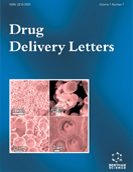Abstract
Background: The objective of this study was to develop liposomal mucoadhesive drug delivery system for the delivery of curcumin via nasal route, to avoid hepatic first pass metabolism, to increase residence time and to investigate its nose to brain delivery potential.
Methodology: The liposomes were prepared by solvent dispersion method using soya lecithin and cholesterol as a lipid phase and xanthan gum as a mucoadhesive polymer. The liposomes were evaluated for particle size, entrapment efficiency, mucoadhesion, DSC, ex vivo permeation, histopathological study, in vitro drug release, and in vivo study for the estimation of drug in brain after intranasal administration.
Results and Discussion: The particle size was in the range of 100.2-150 nm with good stability and controlled release characteristics without any deleterious effect on nasal mucosa of rat. When administered via intranasal route the liposomes showed higher drug distribution in brain (1240 ng) compared to drug solution (65 ng).
Conclusion: The results of the in vivo study suggests that the xanthan gum coated curcumin liposomes is a promising drug delivery system to deliver drug to the brain through nasal route.
Keywords: Curcumin, liposomes, mucoadhesion, nose to brain delivery, solvent dispersion method, xanthan gum.
Drug Delivery Letters
Title:Xanthan Gum Coated Mucoadhesive Liposomes for Efficient Nose to Brain Delivery of Curcumin
Volume: 5 Issue: 3
Author(s): Subodhkant Samudre, Avinash Tekade, Kanchan Thorve, Anup Jamodkar, Gauri Parashar and Nilima Chaudhari
Affiliation:
Keywords: Curcumin, liposomes, mucoadhesion, nose to brain delivery, solvent dispersion method, xanthan gum.
Abstract: Background: The objective of this study was to develop liposomal mucoadhesive drug delivery system for the delivery of curcumin via nasal route, to avoid hepatic first pass metabolism, to increase residence time and to investigate its nose to brain delivery potential.
Methodology: The liposomes were prepared by solvent dispersion method using soya lecithin and cholesterol as a lipid phase and xanthan gum as a mucoadhesive polymer. The liposomes were evaluated for particle size, entrapment efficiency, mucoadhesion, DSC, ex vivo permeation, histopathological study, in vitro drug release, and in vivo study for the estimation of drug in brain after intranasal administration.
Results and Discussion: The particle size was in the range of 100.2-150 nm with good stability and controlled release characteristics without any deleterious effect on nasal mucosa of rat. When administered via intranasal route the liposomes showed higher drug distribution in brain (1240 ng) compared to drug solution (65 ng).
Conclusion: The results of the in vivo study suggests that the xanthan gum coated curcumin liposomes is a promising drug delivery system to deliver drug to the brain through nasal route.
Export Options
About this article
Cite this article as:
Samudre Subodhkant, Tekade Avinash, Thorve Kanchan, Jamodkar Anup, Parashar Gauri and Chaudhari Nilima, Xanthan Gum Coated Mucoadhesive Liposomes for Efficient Nose to Brain Delivery of Curcumin, Drug Delivery Letters 2015; 5 (3) . https://dx.doi.org/10.2174/2210303106666160120215857
| DOI https://dx.doi.org/10.2174/2210303106666160120215857 |
Print ISSN 2210-3031 |
| Publisher Name Bentham Science Publisher |
Online ISSN 2210-304X |
 28
28
- Author Guidelines
- Bentham Author Support Services (BASS)
- Graphical Abstracts
- Fabricating and Stating False Information
- Research Misconduct
- Post Publication Discussions and Corrections
- Publishing Ethics and Rectitude
- Increase Visibility of Your Article
- Archiving Policies
- Peer Review Workflow
- Order Your Article Before Print
- Promote Your Article
- Manuscript Transfer Facility
- Editorial Policies
- Allegations from Whistleblowers
Related Articles
-
Securinine Derivatives as Potential Anti-amyloid Therapeutic Approach
CNS & Neurological Disorders - Drug Targets Novobiocin and Additional Inhibitors of the Hsp90 C-Terminal Nucleotide- binding Pocket
Current Medicinal Chemistry Antibody-Drug Conjugate Targets
Current Cancer Drug Targets Prodigiosins as Anti Cancer Agents: Living Upto Their Name
Current Pharmaceutical Design Breast Cancer: A Review of Risk Factors and New Insights into Treatment
Current Cancer Therapy Reviews Cerebrospinal Fluid Proteomes: From Neural Development to Neurodegenerative Diseases
Current Proteomics MiRNAs in Human Cancers: The Diagnostic and Therapeutic Implications
Current Pharmaceutical Design Voltage-Gated Sodium Channels in Neurological Disorders
CNS & Neurological Disorders - Drug Targets Pharmacology of Cell Adhesion Molecules of the Nervous System
Current Neuropharmacology Recent Patents on Live Bacteria and their Products as Potential Anticancer Agents
Recent Patents on Anti-Cancer Drug Discovery Anticancer Peptides and Proteins: A Panoramic View
Protein & Peptide Letters Dynamic Medicinal Chemistry in the Elaboration of Morphine-6- Glucuronide Analogs
Current Topics in Medicinal Chemistry A Combined Approach with Rituximab Plus Anti-TRAIL-R Agonistic Antibodies for the Treatment of Haematological Malignancies
Current Pharmaceutical Design Fatty Acid Synthase: A Target for the Reversal of Liver Steatosis
Current Enzyme Inhibition Protein Trafficking and Alzheimers Disease
Current Alzheimer Research Regulation of Insulin Release at Pre-exocytotic Stages of the Secretory Process
Current Medicinal Chemistry - Immunology, Endocrine & Metabolic Agents Overcoming the Hurdles of Tumor Immunity by Targeting Regulatory Pathways in Innate and Adaptive Immune Cells
Current Pharmaceutical Design P-Glycoprotein Is Not a Key Target for the Chemosensitizing Effect of 1-Phenyl-2-Decanoylamino-3-Morpholino-1-Propanol in HepG2 Cells Exposed to Doxorubicin
Drug Metabolism Letters The Dual Role of Nitric Oxide in Glioma
Current Pharmaceutical Design Activin and TGF-β Effects on Brain Development and Neural Stem Cells
CNS & Neurological Disorders - Drug Targets


























